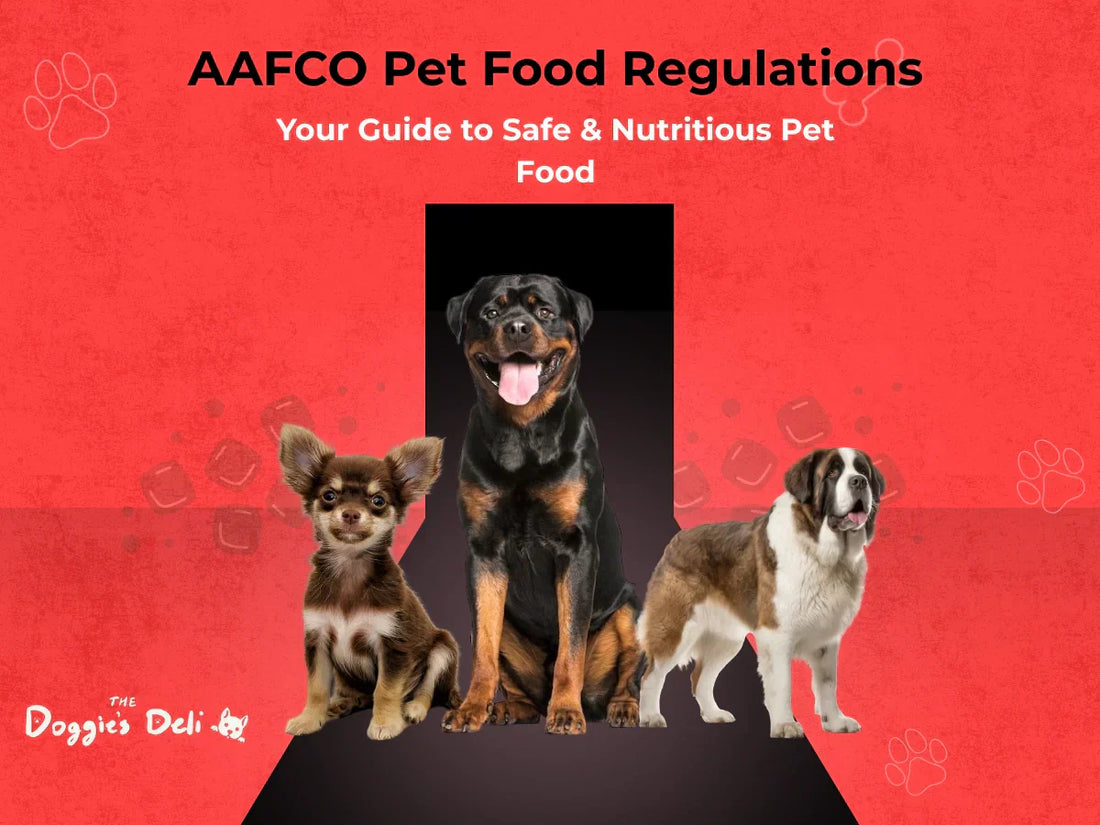
AAFCO Pet Food Regulations: Your Guide to Safe & Nutritious Pet Food
Share
AAFCO is a central authority for developing consistent model guidelines and standards related to pet food ingredients, nutrient content, and labeling. AAFCO’s standards are widely adopted by pet food manufacturers and regulatory bodies to ensure products are safe, balanced, and complete for pets.
AAFCO provides a scientific foundation that helps manufacturers produce pet foods that meet pets’ changing nutritional needs for various life stages, such as growth, reproduction, and adult maintenance. Their guidelines create transparency, helping consumers understand what ingredients are in their pet’s food and how it supports their health.
Understanding AAFCO’s role is essential for pet owners as it enables them to make informed decisions when selecting foods for their pets. Choosing items that meet AAFCO standards can assure owners that the food has undergone feeding trials as well as laboratory analysis.
What is AAFCO? Understanding the American Association of Feed Control Officials
The American Association of Feed Control Officials (AAFCO) is a non-profit organization that sets model guidelines for pet food ingredients, nutrition, and labeling. It was established in 1909 with a mission to develop and promote uniform standards for the quality and safety of animal feed and pet food. They play a crucial role in ensuring consistent quality in pet food, although they don’t have the legal authority to regulate, approve, or enforce pet food laws.
AAFCO plays an important role in pet nutrition by defining nutrient profiles and ingredient standards, recommended minimum and maximum levels of essential nutrients such as proteins, fats, vitamins, and minerals that support the health of pets across different species and their life stages.
This move provides consistency, clarity, and transparency in pet food labeling and allows consumers to understand what their pets are eating. Overall, AAFCO sets guidelines to shape the foundation for pet food safety, labeling, and nutritional quality while not directly regulating or approving pet foods.
The Role of AAFCO in Pet Food Regulation and Standards
AAFCO plays a central role in establishing the standards that define ingredient standards, sets nutrient profiles, and provides labeling guidelines that pet food manufacturers follow to produce balanced and compliant products. Although they don’t have regulatory authority, their guidelines and standards are adopted by state agencies, ensuring consistent pet food quality and safety.
They standardize pet food labeling guidelines that mention information such as nutritional adequacy statements, ingredient lists, guaranteed analysis, and feeding instructions to ensure transparency and protect consumers. This helps pet owners make informed decisions about their pet’s diet.
Brands use AAFCO standards to create pet foods that meet minimum nutritional requirements for specific life stages and communicate safety and quality assurances to consumers. By following their standard guidelines, manufacturing brands ensure their products are accurately labeled, safe, and nutritionally balanced. This also helps brands provide consistent quality, meet regulatory expectations, and build consumer trust.
Key contributions of AAFCO include:

- Defining allowable ingredients in pet food to ensure clarity and uniformity
- Establishing maximum and minimum nutrient profiles for growth, reproduction, and adult maintenance for different species
- Setting labeling standards for pet food labeling, including required disclosures and claims
- Offering feeding trial protocols to verify nutritional adequacy
- Offering guidance on nutrient sources, ingredient safety, and additive use
- Providing a list of acceptable ingredients and prohibited substances
- Initiating collaboration among regulatory bodies, scientific experts, and industry
AAFCO Pet Food Nutrient Profiles and Guidelines Explained
AAFCO's nutrient profiles are organized around life stage-based nutrition to meet pets' changing needs during growth and adulthood. These profiles define the minimum and maximum levels of essential nutrients required for animal health, growth, and maintenance. The nutrient guidelines ensure that pet foods provide balanced diets, proteins, fats, vitamins, carbohydrates, and minerals.
The life stage-based approach reflects the changing nutritional demands of pets as they grow, mature, and age. AAFCO’s guidelines also specify ingredient definitions and allowable additives, which help brands and manufacturers maintain transparency and consistency. The nutrient levels mentioned in the guideline are determined through research and consultation with veterinary nutrition experts for reliability and ensuring the pet’s well-being.
Growth and Reproduction Nutrient Profiles
Puppies and pregnant dogs require increased levels of proteins, fats, vitamins, and minerals to support development, fetal growth, and reproduction. AAFCO’s nutrient profiles specify higher minimums for protein, fat, calcium, phosphorus, and certain vitamins for this life stage to meet their demands. Sufficient nutrition during growth supports proper muscle formation, bone development, immune system strength, and overall vitality.
Adult Maintenance Nutrient Profiles
Adult dogs need balanced nutrients that maintain health, energy levels, and overall condition without excess. AAFCO defines nutrient levels that support stable weight, energy, and overall wellness for mature pets. Additionally, the adult maintenance profiles define balanced nutrient levels to support metabolism, immune health, and organ function while preventing nutrient toxicity and obesity.
How AAFCO Trials Ensure Nutritional Adequacy
AAFCO feeding trials test if a pet food supports health over time for specific life stages, validating claims made by manufacturers. The trials confirm that pet foods meet their nutritional profiles and support the health of pets over time. They also validate whether the diet promotes normal growth, maintenance, reproduction, and overall well-being and ensure the product performs as promised.
- Feeding Trials: Dogs consume the specific types of food under controlled conditions while their health and growth are closely monitored. This ensures the well-being of the dogs involved and contributes to advancements in veterinary science.
- Laboratory Analysis: Ingredients and nutrient content undergo lab testing against AAFCO standards to verify they meet the standard nutrient levels. This process helps maintain product integrity throughout all products.
- Nutritional Adequacy Certificate: This certificate confirms that the food supports the intended life stages and meets established nutritional criteria, giving consumers confidence in the product.
Understanding Regulatory Bodies in Pet Food Safety
AAFCO operates alongside other regulatory agencies that oversee pet food safety, each with distinct roles. They develop model guidelines for pet food ingredients, labeling, and nutrient profiles, however, it doesn’t enforce regulations. Their standards are widely adopted by state agencies that regulate pet food manufacturing and sales within their jurisdictions.
The FDA enforces pet food safety laws, manages recalls, and monitors contamination risks as it is legally authorized to take action against unsafe or misbranded products, unlike AAFCO. In addition, the WSAVA provides global nutritional recommendations for pet health, complementing regulatory standards with veterinary guidance.
Differences Between AAFCO Approval and FDA Pet Food Regulation
The key difference is that AAFCO develops model guidelines and standards for pet food nutrition and labeling, but does not enforce authority. On the other hand, the FDA is a government agency that enforces legal regulations, oversees pet food safety, and has the power to issue recalls.
|
Aspect |
AAFCO |
FDA |
|
Role |
Provides model guidelines and standards |
Enforces legal regulations and monitors safety risks and recalls |
|
Regulatory Authority |
Non-governmental, advisory |
Government agency with enforcement |
|
Focus |
Nutritional adequacy and labeling |
Food safety, contamination, and recalls |
WSAVA Guidelines vs. AAFCO Standards: What You Need to Know
WSAVA provides global nutritional recommendations that focus on best practices for diet formulation and overall pet health worldwide. Whereas, AAFCO offers the U.S.A.-focused regulatory standards that set specific nutrient profiles, labeling rules, and ingredient definitions.
|
Aspect |
WSAVA |
AAFCO |
|
Scope |
Global nutritional recommendations |
U.S.-focused regulatory standards |
|
Application |
Guides veterinarians and formulators globally |
Guides pet food manufacturers and regulators in the U.S. |
|
Focus |
Overall, pet health and nutrition best practices |
Nutrient profiles, ingredients, and labeling standards |
Popular AAFCO Approved Dog Food and Puppy Food Brands
Several well-known brands meet AAFCO nutritional standards for dogs and puppies, ensuring balanced nutrition and safe diets for pets at various life stages. These brands are reliable choices for pet owners seeking compliance-backed nutrition. They produce foods that support growth, maintenance, and overhealth, and are compliant with AAFCO standards.
Selecting AAFCO-approved products ensures pet owners that the food meets scientifically established guidelines and provides complete and balanced nutrition.
Some popular AAFCO-approved dog food brands include:
- Blue Buffalo
- Royal Canin
- Nutro
- Purina Pro Plan
- Hill’s Science Diet
- Wellness Complete Health
- Canidae
- Merrick
- Orijen
How to Read and Understand AAFCO Statements on Pet Food Labels?
Understanding AAFCO statements on pet food labels is crucial for choosing the right diet for your pet. It helps identify if a product meets nutritional needs and is suitable for life stages such as reproduction, growth, or adult maintenance.
Being able to understand labels helps owners make informed decisions and avoid buying inappropriate diets. As a responsible pet owner, you should look for phrases like “Animal feeding tests using AAFCO procedures” or “AAFCO Dog Food Nutrient Profiles” to ensure the product meets nutritional adequacy.
- Example: “Formulated to meet AAFCO Dog Food Nutrient Profiles for adult maintenance” means the food is lab-tested and suitable for healthy adult dogs, but not necessarily for puppies or pregnant dogs.
Some common phrases like “complete and balanced” indicate that the food meets the minimum nutrient profiles, and “All life stages” means the food supports dogs of all ages or conditions. Overall, reading labels carefully ensures pets get foods suitable for their specific life stage.
Vet Approved Dog Food: Why AAFCO Compliance Matters
Veterinarians rely on AAFCO standards when recommending pet foods because these guidelines ensure the food meets scientifically established nutritional requirements and supports pet health and safety. AAFCO certification builds consumer trust by confirming that standardization helps vets trust the products they suggest will meet pets’ dietary needs.
Also, AAFCO compliance builds confidence that the food is safe, accurately labeled, and properly formulated. Pet foods that meet AAFCO standards and guidelines undergo strict testing and feeding trials to reduce the risk of excesses or nutritional deficiencies. The standard compliance supports pet health and safety, making AAFCO-approved foods a reliable choice endorsed by professionals.
Homemade Dog Food and AAFCO Guidelines
Although the trend of homemade dog meals has grown, nutritional gaps pose risks. While homemade dog food offers benefits like transparency and customization, it carries significant risks of imbalance or nutrient deficiencies that can lead to developmental issues and long-term health problems.
Aligning recipes with AAFCO guidelines helps avoid deficiencies and maintain balanced nutrition. It provides scientifically established nutrient profiles that define the required levels of proteins, vitamins, fats, minerals, and other nutrients for different life stages. Pet owners can ensure their homemade meals supply complete and balanced nutrition by adhering to AAFCA standards. This also helps maintain optimal health and prevents the risks associated with imbalanced homemade foods.
AAFCO Homemade Dog Food Recipes
Homemade recipes aligned with AAFCO focus on nutrient balance and combine whole foods with necessary supplements to ensure dogs receive complete and balanced nutrition that supports their overall well-being.
How to Safely Prepare Home-Cooked Dog Food?
Use high-quality, fresh ingredients and follow recipes that meet nutritional requirements to safely prepare home-cooked dog food. It should be cooked thoroughly to eliminate harmful bacteria, practice good hygiene, and avoid toxic ingredients like onion, garlic, raisins, grapes, chocolate, and xylitol.
The Doggie's Deli Organic Treats: Ensuring AAFCO Compliance and Nutritional Safety for Your Pet
The Doggie's Deli offers reliable, FDA-approved organic treats that comply with AAFCO standards, ensuring every treat meets nutritional and safety guidelines. Made from carefully selected high-quality ingredients, these treats combine taste and nutritional value at once with the assurance of AAFCO-backed quality. Treat your pets with the goodness of natural treats without compromising on nutrition and safety. Choose The Doggie's Deli Organic Treats today and provide healthy treats that support your pet’s health, backed by regulatory compliance.
Frequently Asked Questions
What Does AAFCO Stand For?
AAFCO stands for the American Association of Feed Control Officials. It is an independent organization that guides state, federal, and international feed regulators with ingredient definitions, laboratory standards, and label standards.
What Are AAFCO Feeding Trials?
They are controlled tests where pets eat the food for a set time while their health is monitored to verify the food’s nutritional adequacy. This is to ensure that all pet food is healthy and nutritional and doesn’t cause obesity and nutritional deficiencies.
How to Switch Dog Food Safely Under AAFCO Guidance?
To switch dog food safely under AAFCO guidance, gradually mix the new food with the current one over a 7–10 day period. The slow transition to new food helps avoid digestive upset and adjust comfortably.
What Are the 3 Dangerous Ingredients to Avoid in Dog Food?
The three dangerous ingredients to avoid in dog food are artificial preservatives, meat by-products, and artificial colors or flavors that can cause health issues over time.










